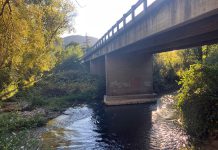Delaying the dam
EDITOR: In Rollie Atkinson’s article, “The saga of building Warm Springs Dam” dated online Sept. 1, he states, “The dam project was extremely controversial and took 21 years from groundbreaking to final construction due to “anti-growth and seismic safety lawsuits and two countywide voter referendums.”
I was co-chair of the Warm Springs Dam task force, which opposed the dam. And when we put it on the ballot in 1974, close to half of Sonoma County’s residents opposed it.
Rollie raised the two major objects we had to the dam, “anti-growth and seismic safety lawsuits”:
1. Anti-growth. In reviewing the appropriations documents before Congress for five years before I spoke up, it was clear that the purpose of the dam was create a water supply to urbanize Sonoma County, converting it from primarily agricultural land to suburbs and shopping centers. Think Silicon Valley.
2. Seismic safety lawsuits. Can this concern be easily dismissed? When the task force took the Corps to federal district court, a world-famous seismologist testified that he would not feel safe living in Healdsburg because the Corps had ignored its own specs for compacting the dam embankment. They had to take it down and start over.
Another reason for the delay is that the Army Corps had failed to produce an Environmental Impact Statement (EIS), as required by the National Environmental Policy Act passed in 1970. When we challenged this, they had to stop the project and do the E.I.S. Unfortunately, the Corp ignored the mandated consideration in the E.I.S. of an alternative to the dam, groundwater.
The benefits gained by our opposition to the dam is that it resulted in a safer project and with the delay, primarily a result of the Corps own actions, we were able to enact land use laws creating separators between our cities and avoiding the urban sprawl that has become a blight elsewhere.
Gail Jonas
Healdsburg
Drought should bring cannabis moratorium
EDITOR: Drought, drought, drought. Sonoma County is experiencing its worst drought in decades. Our reservoirs are at an all-time low, and even with conservation measures, our officials estimate only enough water for another year or so. It’s safe to assume homes relying on ground water (wells) are facing the same dire consequences. Sonoma County is appealing its new housing allocation (requesting a lower number), citing the drought and an unclear picture on where the required water would come from.
On Aug. 3, The State of California issued emergency orders to take only enough water out of the Russian river for “basic human health and safety needs.”
Supervisor Hopkins was quoted as saying “In my opinion, if it’s not something you’re going to eat, maybe you shouldn’t be watering it”. In response to Sonoma County recent draft amendment to the Cannabis Ordinance, both the Department of Fish and Game and the National Marine Fisheries Service stated that a complete and thorough water study is necessary before proceeding with any new projects.
In light the uncertain water future, the Board of Supervisor should place a moratorium on all commercial cannabis cultivation operations until our water supply is assured and safeguarded.
Bill Krawetz
Sebastopol
At the bottom of the lake
EDITOR: A follow up on the Lake Sonoma article — silt is collecting in Lake Sonoma. During the last drought when I asked Grant Davis, the director of Sonoma Water about that, he replied, “that was the responsibility of the Corp of Engineers and they say it is our responsibility”. Some other reservoirs around the country and around the world remove silt regularly to preserve the capacity. Recent emails to Grant and the chief engineer were not answered. The public deserves to know how fast the lake is filling up with soil and what can be done about it.
Terry Harrison
Healdsburg








